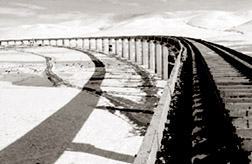|
observer |
|
|
|
|
|
OTHER LINKS |

|

|

|
Tibet railway - reaches out to touristsTibet, known as the "Roof of the World" lies on the Qinhai-Tibet plateau averaging 4000 meters above sea level. Due to its geographical location reaching Tibet by road was extremely difficult and dangerous with no lodging or fuel station found on the 15 day drive from Beijing. Impossibility of communication with another human being throughout the journey was dreadful. To see overturned trucks and vehicles on the way was not a rare vision.
Its cut off, at times for some reason made adverse effects on Tibet's economy. Besides, their transportation was extremely difficult due to rough weather conditions. No doubt, the fragile nature of the highway network was one of the key factors behind the low development of Tibet after its liberation in 1959. The situation of the highway in Lhasa, the capital of Tibet was even worse. Before the founding of the People's Republic of China, there was only one Km clay road in Lhasa. In 1930, the then Dalai Lama who had a craving for a luxury car had transported a vehicle piece by piece on an animal's back and reassembled it with the help of a foreign technician only to be left in a garage to rust as there were no roads to drive on except for the one Km clay road. When compared with the 43000 Km the region had by the end of 2005, it is not difficult to understand the pathetic situation Tibet had undergone before the revolution, despite crocodile tears shed by some reactionary elements in the west. Therefore, the importance of a railway line that would connect Tibet with other parts of the country had become a long felt necessity. The idea of putting up a railway track to Tibet was first conceived in the mind of Dr. Sun Yat Sen as far back as 1919. But it remained unfulfilled for several decades owing to lack of adequate funds and engineering skills. Indeed, China was lagging far behind when compared with rest of the world before the revolution in 1949. Building a long railway track of this nature was only conceptual. With the emergence of new China under the leadership of Chairman Mao-Tse-Tung, wider attention was paid in this connection with enhanced capacity and vigour. With the introduction of open Policies in 1978 China has made a substantial progress in moving towards a market economy and liberating trade. Transformation of economic life from a centrally planned economy to an emerging market oriented economy has given the Chinese people ample opportunities to achieve higher living standards becoming far more prosperous than ever before.
Construction of Qinhai-Tibet railway track which runs parallel to 2055 Km highway through the Gobi Desert and snowy mountains was an arduous task that consumed a huge capital. From time to time construction work had been suspended caused by technical and financial problems and carrying on engineering projects under insufficient oxygen and severe cold at high altitude were no exemptions. Before 1984 the existing railway line was only up to Xining, capital of Qinhai and the first part beyond that point to the city of Golmud, near the Kunlum Mountains in Qinhai completed in 1979 but its operation began in 1984. To embrace the entire project second phase from Golmud to Lhasa had to be completed and construction work began only in 2001 after a lapse of two decades. By 2005 laying of the track for the entire line was completed and the Qinhai-Tibet railway went in to trial operation on July 1, this year fulfilling a long felt dream in China's railway history. Since the mystery of Tibet has long held a fascination for travellers, the completion of Qinhai-Tibet railway line, the highest operating railway in the world would definitely be a welcome message to tourists, the world over. In the past, it took 15 long days to reach Lhasa from Beijing by road and the number of hours has now been reduced to 48, thanks to the railway. Tourists used to travel by air had to incur a high cost of airfare making an adverse impact on the purse of those with a moderate income. Apart from that many people would have a liking to travel by train so they could enjoy beautiful scenery throughout their journey at a very much lower price than the airfare. |
 There were five national highways connected to Tibet with rest of the
world but only one road was open year round, due to geological and
climatic conditions. More that 90 per cent of passengers and greater
part of commodities in and out of Tibet, were transported through Qinhai-Tibet
highway.
There were five national highways connected to Tibet with rest of the
world but only one road was open year round, due to geological and
climatic conditions. More that 90 per cent of passengers and greater
part of commodities in and out of Tibet, were transported through Qinhai-Tibet
highway.  After more than 25 years of reform and liberalization, the
achievements China has made in the fields of economy education, defense,
agriculture, engineering and other important sectors are far more
superior than the achievements recorded during the post revolutionary
period till 1978 but in no way underline the greatest ever contribution
made by Chairman Mao who laid the foundation for a modern socialist
country.
After more than 25 years of reform and liberalization, the
achievements China has made in the fields of economy education, defense,
agriculture, engineering and other important sectors are far more
superior than the achievements recorded during the post revolutionary
period till 1978 but in no way underline the greatest ever contribution
made by Chairman Mao who laid the foundation for a modern socialist
country. 






